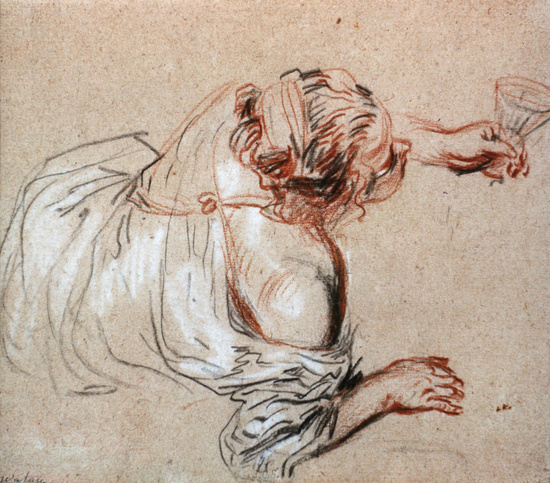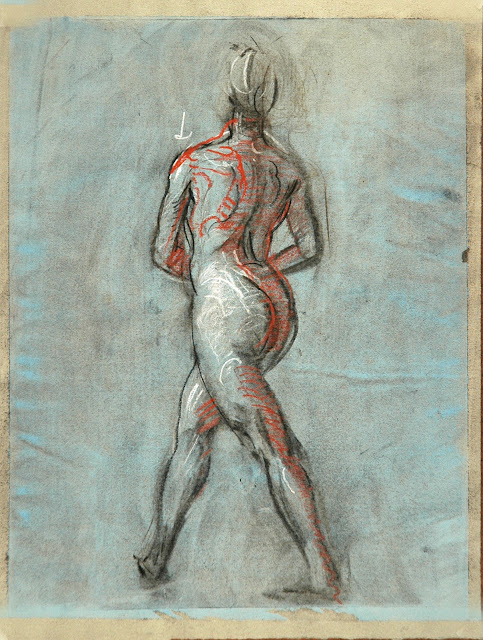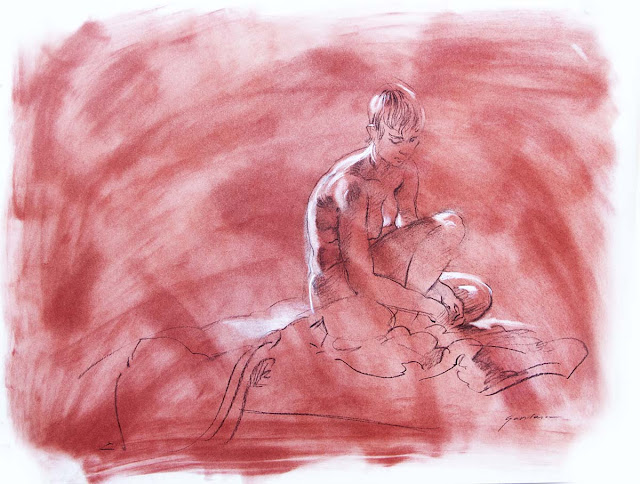The Expressive Figure Assignment
Concept: Trois Crayon
Materials
- Vine or Willow Jumbo Charcoal ( Generals/ Coates)" Thin, Medium, and Jumbo.
- Canson Mi Tientes toned paper, Strathmore toned paper, or 90 lb drawing paper 12" x 19" or similar sketchbook
- Faber-Castell Kneaded Eraser
- Pan Pastel Rw Sienna Tint , Burnt Sienna, or color of your choosing.
- Pastel chalk ( Prismacolor Nupastel ) or similar "hard pastel" recommended colors Ivory White, Venetian Red, Sepia, (any of the earth reds)
- Carb-Othello Pastel Pencils recommended colors Ivory White, Venetian Red, Sepia, (any of the earth reds) or colors of your choosing
Starting with Charcoal , quickly sketch and draw a gestural mannikin of the pose with an emphasis on the center of gravity (Isonomia) Rythmos (action), with the geometric approximations of a Manniken foremost, (Peanut/Torso, Cylinders/Arms and Legs, Neck, Spheroid /Head). This should take 60 seconds or less and be in the spirit of what Michelangelo called "the Flame". Think of it as three helixes wrapping around a central core, like ribbons or strands of flame rising and converging above.
With the template of the mannikin pose as a guide, consider how the volumes of the "peanut", "cylinders, and "ovoid" describe the volumes "in space" and can taper as they move away from us and loom larger the closer they are to us. Be cognizant of this "in and out" spatial occupancy.
Choose three poses and explore the technique of :
Trois Crayon
Reductive Technique on Tone Paper
Using the trois crayon technique of
Red Ochre
Charcoal/Black
White/Ivory
Trois crayons English: "three chalks") is a drawing technique using three colors of chalk: red (sanguine), black (a type of schist), and white. The paper used may be a mid-tone such as grey, blue, or tan. Among numerous others, French painters Antoine Watteau and François Boucher drew studies of figures and drapery aux trois crayons. The technique was, most notably, pioneered and popularised by the Flemish master Peter Paul Rubens.
The trois crayons drawing technique has its roots in the second half of the 15th century in Europe. During this period, artists began drawing with natural red chalk along with limited natural chalk. As drawing techniques evolved, artists combined red chalk with other chalks, including white chalk. The use of white chalk allowed artists to enhance lighting effects in their drawings. However, since white chalk was barely visible on white paper or parchment, artists began to use a toned background to allow the technique to work effectively. During the 16th century, artists developed sophisticated drawing techniques, such as in matita rossa e nera ("in red and black chalk pencils") known in Italy, and aux deux crayons ("with two chalk pencils") known in France. In the early 17th century, the technique developed further combining red, white, and black chalk to produce the aux trois crayons ("with three chalk pencils") technique, typically executed on blue or tan colored paper. The trois crayons technique was developed most completely in the 18th century.
The methods of blending and layering the colors in the trois crayons technique involve a step-by-step process of setting proportion and organization, introducing mass shadows, developing shadows and light, and rendering the lights with varying intensity. By combining red, black, and white chalk artists create vivid and vibrant drawings. The method promotes color harmony with its limited range of colors, making it efficient and creative. Materials used include red, black, and white chalk, pigmented pencils, and specific paper. The results demonstrate how the trois crayons technique can create compelling artwork.
Peter Paul Rubens
Antoine Watteau






























No comments:
Post a Comment